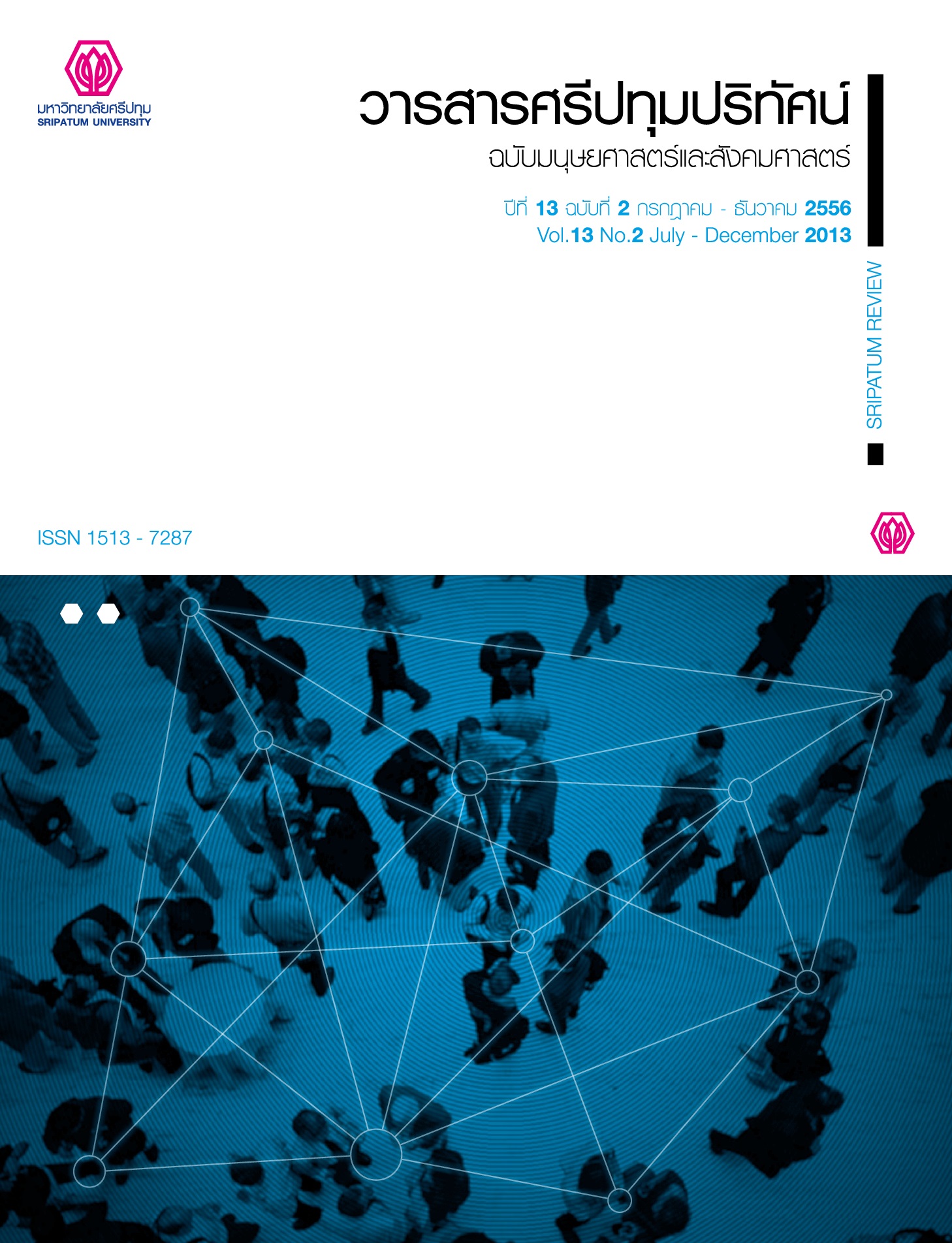THE DEVELOPMENT OF FEACA MODEL TO ENHANCE STUDENTS’ CONCEPTUAL UNDERSTANDING, ANALYTICAL THINKING, AND APPLICATION OF KNOWLEDGE
Main Article Content
Abstract
The purpose of this study was to develop the science instructional model called FEACA Model for lower secondary school students in order to enhance students’ conceptual understanding, analytical thinking, and application of knowledge. This science instructional model emphasizing contextual approach consisted of 5 steps of learning, namely, focusing, exploring, analyzing, conceptual developing, and applying. This study was a quasi-experimental research with the pretest-posttest non-equivalent control group design. The research sample consisted of Mathayom Suksa 3 (Ninth Grade) students in two intact classrooms. One classroom was assigned as the experimental group to be taught with the FEACA Model while the other was assigned as the control group to be taught with the traditional instruction. The research instruments consisted of the learning unit, a conceptual understanding test, an analytical thinking test, and an application of knowledge test. The findings suggested that the experimental group students’ scores on conceptual understanding, analytical thinking, and application of knowledge were significantly higher than the control group students’ counterpart scores at the .01 and .05 levels.
Article Details
1. กองบรรณาธิการสงวนสิทธิ์ในการพิจารณาและตัดสินการตีพิมพ์บทความในวารสาร
2. บทความทุกเรื่องจะได้รับการตรวจสอบทางวิชาการโดยผู้ทรงคุณวุฒิ แต่ข้อความและเนื้อหาในบทความที่ตีพิมพ์เป็นความรับผิดชอบของผู้เขียนแต่เพียงผู้เดียว มิใช่ความคิดเห็นและความรับผิดชอบของมหาวิทยาลัยศรีปทุม
3. การคัดลอกอ้างอิงต้องดำเนินการตามการปฏิบัติในหมู่นักวิชาการโดยทั่วไป และสอดคล้องกับกฎหมายที่เกี่ยวข้อง
References
Ministry of Education. (2008). The Basic Education Core Curriculum B.E. 2551 (A.D. 2008). Bangkok: Kurusapa Ladprao Publishing.
The International Association for the Evaluation of Educational Achievement (IEA). (2008). TIMSS 2007 International Science Report: Findings from IEA’s Trends in International Mathematics and Science Study at the Fourth and Eighth Grades. Massachusetts: TIMSS & PIRLS International Study Center.
The National Institute of Education Testing Service (Public Organization) (NIETS). (2010). The Basic statistics of O-Net scores Grade 6 and Grade 9 in 2010 academic year. Retrieved January 8, 2012.
The Office for National Education Standards and Quality Assessment (Public Organization) (ONESQA). (2008). Annual report 2008. Bangkok.
Phetdee, Wannapa. (2009). Students must Learn to Think. The Nation, Retrieved August 9, 2009.
Educational Broadcasting Corporation. (2004). Constructivism as a Paradigm for Teaching and Learning. Retrieved October 13, 2009.
Whitelegg, E. & Parry, M. (1999). Real-life Context for Learning Physics: Meanings, Issues and Practice. Physics Education. 34(2), 68-72.
Souders, J. C. & Prescott, C. (1999). A Case for Contextual Learning. Schools in the Middle. 9(3), 7-10.
Jong, O. (2008). Context-based Chemical Education: How to improve it?. Chemical Educational International. 8(1), 1-7.
Glynn, S. & Koballa, R. (2005). The Contextual Teaching and Learning Instructional Approach. Exemplary Science: Best Practices in Professional Development. Arlington, VA: National Science Teachers Association Press.
Choi, J., & Johnson, S. (2005). The Effect of Context-based Video Instruction on Learning and Motivation in Online Courses. The American Journal of Distance Education. 19(4), 215-227.
Marzano, R. (2001). Designing a New Taxonomy of Educational Objectives. California: Corwin Press.
Thornton, R., & Sokoloff, D. (1998). Assessing Student Learning of Newton’s Laws: The Force and Motion Conceptual Evaluation and the Evaluation of Active Learning Laboratory and Lecture Curricula. American Journal of Physics. 66, 338-352.
Lubben, F., Campbell, B, & Dlamini, B. (1996). Contextualizing Science Teaching in Swaziland: some student reactions. International Journal of Science Education. 18, 311-320.
Kruatong, Tussatrin. (2007). The Development of High School Students Understanding and Application of Heat and Thermodynamics Concepts through a Contextual Approach. Doctorial dissertation, Kasetsart University. Bangkok.
Bennett, J., & Lubben, F. (2006). Context-Based Chemistry: The Salters Approach. International Journal of Science Education. 28(9), 999-1015.
Rennie, L.J., & Parker, L. H. (1996). Placing Physics Problems in Real-life Context: Students’ Reactions and Performance. Australian Science Teacher Journal. 42, 55-59.
Macklin, A. & Fosmire, M. (2003). Real-World Solutions for Real-World Collaboration Problems. Libraries Research Publications. Paper 41. Retrieved May 23, 2010.
Harris, R. (1995). Competency-based Education and Training: Between a Rock and a Whirlpool. South Yarra: Macmillan Publishers Australia.
Orange, C. (2002). The Quick Reference Guide to Educational Innovations: Practices, Programs, Policies, and Philosophies. California: Corwin Press.
Sriputon, Akanid. (2001). A Study of Ability to Apply Science Knowledge in Daily Life of Student in Mathayomsuksa 3 at School in St.Paul De Chartres Group. Bangkok: King Mongkut's Institute of Technology Ladkrabang.
Tunpiriyakul, Varaporn. (2003). The Study Chemical Knowledge Applying Ability in Daily Life of High Vacational Education Certificate Students under the Vacational College Division in Bangkok. Bangkok: King Mongkut's Institute of Technology Ladkrabang.


